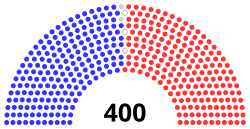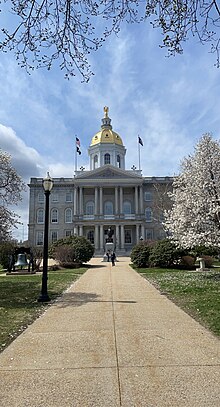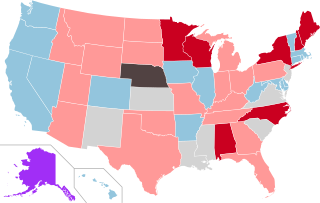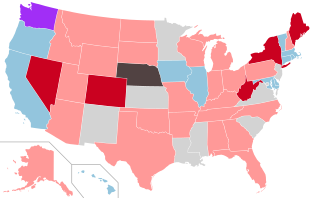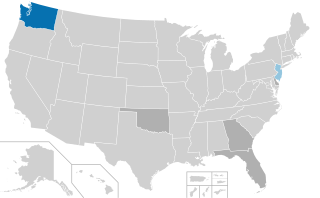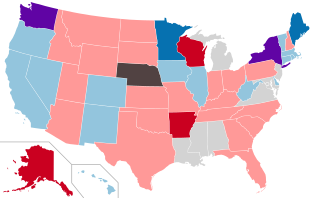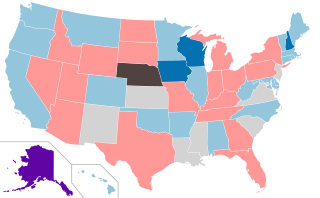- ▌ Tom Ploszaj (R, Belk. 1)
- ▌ Matthew Coker (R, Belk. 2)
- ▌ Lisa Smart (R, Belk. 2)
- ▌ Juliet Harvey-Bolia (R, Belk. 3)
- ▌ Travis O'Hara (R, Belk. 4)
- ▌ Steven Bogert (R, Belk. 5)
- ▌ Mike Bordes (R, Belk. 5)
- ▌ David Huot (D, Belk. 5)
- ▌ Charlie St. Clair (D, Belk. 5)
- ▌ Harry Bean (R, Belk. 6)
- ▌ Richard Beaudoin (R, Belk. 6)
- ▌ Russell Dumais (R, Belk. 6)
- ▌ David Nagel (R, Belk. 6)
- ▌ Barbara Comtois (R, Belk. 7)
- ▌ Paul Terry (R, Belk. 7)
- ▌ Peter Varney (R, Belk. 7)
- ▌ Nikki McCarter (R, Belk. 8)
- ▌ Douglas Trottier (R, Belk. 8)
- ▌ Thomas Buco (D, Carroll 1)
- ▌ David Paige (D, Carroll 1)
- ▌ Stephen Woodcock (D, Carroll 1)
- ▌ Anita Burroughs (D, Carroll 2)
- ▌ Chris McAleer (D, Carroll 2)
- ▌ Richard Brown (R, Carroll 3)
- ▌ Karel Crawford (R, Carroll 3)
- ▌ Lino Avellani (R, Carroll 4)
- ▌ Mike Belcher (R, Carroll 4)
- ▌ Jonathan Smith (R, Carroll 5)
- ▌ John MacDonald (R, Carroll 6)
- ▌ Katy Peternel (R, Carroll 6)
- ▌ Glenn Cordelli (R, Carroll 7)
- ▌ Michael Costable (R, Carroll 8)
- ▌ Mark McConkey (R, Carroll 8)
- ▌ Nicholas Germana (D, Chesh. 1)
- ▌ Dru Fox (D, Chesh. 2)
- ▌ Philip Jones (D, Chesh. 3)
- ▌ Jodi Newell (D, Chesh. 4)
- ▌ Lucy Weber (D, Chesh. 5)
- ▌ Michael Abbott (D, Chesh. 6)
- ▌ Cathryn Harvey (D, Chesh. 6)
- ▌ Shaun Filiault (I, Chesh. 7)
- ▌ Lucius Parshall (D, Chesh. 8)
- ▌ Dan Eaton (D, Chesh. 9)
- ▌ Barrett Faulkner (D, Chesh. 10)
- ▌ Bruce Tatro (D, Chesh. 10)
- ▌ Zachary Nutting (R, Chesh. 11)
- ▌ Dick Thackston (R, Chesh. 12)
- ▌ Richard Ames (D, Chesh. 13)
- ▌ John B. Hunt (R, Chesh. 14)
- ▌ Renee Monteil (D, Chesh. 15)
- ▌ Amanda Toll (D, Chesh. 15)
- ▌ Joe Schapiro (D, Chesh. 16)
- ▌ Jennifer Rhodes (R, Chesh. 17)
- ▌ Jim Qualey (R, Chesh. 18)
- ▌ Matthew Santonastaso (R, Chesh. 18)
- ▌ Sean Durkin (R, Coös 1)
- ▌ James Tierney Jr. (R, Coös 1)
- ▌ Arnold Davis (R, Coös 2)
- ▌ Mike Ouellet (R, Coös 3)
- ▌ Seth King (R, Coös 4)
- ▌ Corinne Cascadden (D, Coös 5)
- ▌ Henry Noel (D, Coös 5)
- ▌ Michael Murphy (R, Coös 6)
- ▌ Eamon Kelley (D, Coös 7)
- ▌ Linda Massimilla (D, Graf. 1)
- ▌ David Rochefort (R, Graf. 1)
- ▌ Matthew Simon (R, Graf. 1)
- ▌ Jared Sullivan (D, Graf. 2)
- ▌ Jerry Stringham (D, Graf. 3)
- ▌ Heather Baldwin (D, Graf. 4)
- ▌ Matthew Coulon (R, Graf. 5)
- ▌ Rick Ladd (R, Graf. 5)
- ▌ Jeffrey Greeson (R, Graf. 6)
- ▌ Tommy Hoyt (D, Graf. 7)
- ▌ Bill Bolton (D, Graf. 8)
- ▌ Sallie Fellows (D, Graf. 8)
- ▌ Peter Lovett (D, Graf. 8)
- ▌ Corinne Morse (D, Graf. 9)
- ▌ Carroll Brown Jr. (R, Graf. 10)
- ▌ Lex Berezhny (R, Graf. 11)
- ▌ Mary Hakken-Phillips (D, Graf. 12)
- ▌ Russell Muirhead (D, Graf. 12)
- ▌ James Murphy (D, Graf. 12)
- ▌Vacant (Graf. 12)
- ▌ Laurel Stavis (D, Graf. 13)
- ▌ George Sykes (D, Graf. 14)
- ▌ Thomas H. Cormen (D, Graf. 15)
- ▌ David Fracht (D, Graf. 16)
- ▌ Susan Almy (D, Graf. 17)
- ▌ John Sellers (R, Graf. 18)
- ▌ Kimberly Abare (R, Hills. 1)
- ▌ Tom Mannion (R, Hills. 1)
- ▌ Sandra Panek (R, Hills. 1)
- ▌ Jeffrey Tenczar (R, Hills. 1)
- ▌ Loren Foxx (D, Hills. 2)
- ▌ Ted Gorski (R, Hills. 2)
- ▌ Linda Gould (R, Hills. 2)
- ▌Vacant (Hills. 2)
- ▌ Kristin Noble (R, Hills. 2)
- ▌ Catherine Rombeau (D, Hills. 2)
- ▌ Laurie Sanborn (R, Hills. 2)
- ▌ Paige Beauchemin (D, Hills. 3)
- ▌ Fred Davis Jr. (D, Hills. 3)
- ▌ Marc Plamondon (D, Hills. 3)
- ▌ Ray Newman (D, Hills. 4)
- ▌ Sue Newman (D, Hills. 4)
- ▌ Linda Ryan (D, Hills. 4)
- ▌ Shelley Devine (D, Hills. 5)
- ▌ Susan Elberger (D, Hills. 5)
- ▌ Heather Raymond (D, Hills. 5)
- ▌ Sherry Dutzy (D, Hills. 6)
- ▌ Carry Spier (D, Hills. 6)
- ▌ Suzanne Vail (D, Hills. 6)
- ▌ Alicia Gregg (D, Hills. 7)
- ▌ Louis Juris (D, Hills. 7
- ▌ Catherine Sofikitis (D, Hills. 7)
- ▌ Efstathia Booras (D, Hills. 8)
- ▌ Christal Lloyd (D, Hills. 8)
- ▌ Fran Nutter-Upham (D, Hills. 8)
- ▌ William Dolan (D, Hills. 9)
- ▌ Allison Nutting-Wong (D, Hills. 9)
- ▌ Michael Pedersen (D, Hills. 9)
- ▌ Linda Harriott-Gathright (D, Hills. 10)
- ▌ Marty Jack (D, Hills. 10)
- ▌ Michael O'Brien (D, Hills. 10)
- ▌ William Darby (D, Hills. 11)
- ▌ Latha Mangipudi (D, Hills. 11)
- ▌ Laura Telerski (D, Hills. 11)
- ▌ William Boyd III (R, Hills. 12)
- ▌ Robert Healey (R, Hills. 12)
- ▌ Tim McGough (R, Hills. 12)
- ▌ Maureen Mooney (R, Hills. 12)
- ▌ Nancy Murphy (D, Hills. 12)
- ▌ Jeanine Notter (R, Hills. 12)
- ▌ Rosemarie Rung (D, Hills. 12)
- ▌ Wendy Thomas (D, Hills. 12)
- ▌ Stephen Kennedy (R, Hills. 13)
- ▌ Cathy Kenny (R, Hills. 13)
- ▌ Andrew Prout (R, Hills. 13)
- ▌ Andrew Renzullo (R, Hills. 13)
- ▌ Jordan Ulery (R, Hills. 13)
- ▌ Robert Wherry (R, Hills. 13)
- ▌ Ralph Boehm (R, Hills. 14)
- ▌ Richard Lascelles (R, Hills. 14)
- ▌ Mark McLean (R, Hills. 15)
- ▌ Mark Proulx (R, Hills. 15)
- ▌ Larry Gagne (R, Hills. 16)
- ▌ William Infantine (R, Hills. 16)
- ▌ Linda DiSilvestro (D, Hills. 17)
- ▌ David Preece (D, Hills. 17)
- ▌ Jessica Grill (D, Hills. 18)
- ▌ Juliet Smith (D, Hills. 18)
- ▌ Jane Beaulieu (D, Hills. 19)
- ▌ Heidi Hamer (D, Hills. 19)
- ▌ Candace Moulton (D, Hills. 20)
- ▌ Alissandra Murray (D, Hills. 20)
- ▌ Jeffrey Goley (D, Hills. 21)
- ▌ Christine Seibert (D, Hills. 21)
- ▌ Patricia Cornell (D, Hills. 22)
- ▌ Nicole Leapley (D, Hills. 22)
- ▌ Jean Jeudy (D, Hills. 23)
- ▌ Patrick Long (D, Hills. 23)
- ▌ Donald Bouchard (D, Hills. 24)
- ▌ Christopher Herbert (D, Hills. 24)
- ▌ Amanda Bouldin (D, Hills. 25)
- ▌ Kathy Staub (D, Hills. 25)
- ▌ Brian Cole (R, Hills. 26)
- ▌ Mary Freitas (D, Hills. 26)
- ▌ Karen Reid (R, Hills. 27)
- ▌ Leah Cushman (R, Hills. 28)
- ▌ Keith Erf (R, Hills. 28)
- ▌ Joe Alexander (R, Hills. 29)
- ▌ Judi Lanza (D, Hills. 29)
- ▌ Fred Plett (R, Hills. 29)
- ▌ Sheila Seidel (R, Hills. 29)
- ▌ Richie Colcombe (R, Hills. 30)
- ▌ Jim Creighton (R, Hills. 30)
- ▌ Jim Fedolfi (R, Hills. 30)
- ▌ Molly Howard (D, Hills. 31)
- ▌ Diane Kelley (R, Hills. 32)
- ▌ Jim Kofalt (R, Hills. 32)
- ▌ Shane Sirois (R, Hills. 32)
- ▌ Peter Leishman (D, Hills. 33)
- ▌ Jonah Wheeler (D, Hills. 33)
- ▌ Daniel LeClerc (D, Hills. 34)
- ▌ Jennifer Morton (D, Hills. 34)
- ▌ Daniel Veilleux (D, Hills. 34)
- ▌ Kat McGhee (D, Hills. 35)
- ▌ Ben Ming (D, Hills. 35)
- ▌ John Lewicke (R, Hills. 36)
- ▌ Diane Pauer (R, Hills. 36)
- ▌ Megan Murray (D, Hills. 37)
- ▌ Alicia Lekas (R, Hills. 38)
- ▌ Tony Lekas (R, Hills. 38)
- ▌ Benjamin Baroody (D, Hills. 39)
- ▌ Ross Berry (R, Hills. 39)
- ▌ Damond Ford (D, Hills. 40)
- ▌ Mark MacKenzie (D, Hills. 40)
- ▌ Trinidad Tellez (D, Hills. 40)
- ▌ Matthew Wilhelm (D, Hills. 40)
- ▌ Amy Bradley (D, Hills. 41)
- ▌ Jacqueline Chretien (D, Hills. 41)
- ▌ Mary Heath (D, Hills. 41)
- ▌ Keith Ammon (R, Hills. 42)
- ▌ Gerald Griffin (R, Hills. 42)
- ▌ Lisa Post (R, Hills. 42)
- ▌ Bill King (R, Hills. 43)
- ▌ Maria Perez (I, Hills. 43)
- ▌ Peter Petrigno (D, Hills. 43)
- ▌ Vanessa Sheehan (R, Hills. 43)
- ▌ Travis Corcoran (R, Hills. 44)
- ▌ Lisa Mazur (R, Hills. 44)
- ▌ Karen Calabro (D, Hills. 45)
- ▌ Lorrie Carey (D, Merr. 1)
- ▌ Gregory Hill (R, Merr. 2)
- ▌ James Mason (R, Merr. 3)
- ▌ Dave Testerman (R, Merr. 3)
- ▌ Jose Cambrils (R, Merr. 4)
- ▌ Michael Moffett (R, Merr. 4)
- ▌ Louise Andrus (R, Merr. 5)
- ▌ Deborah Aylward (R, Merr. 5)
- ▌ Thomas Schamberg (D, Merr. 6)
- ▌ Karen Ebel (D, Merr. 7)
- ▌ Dan Wolf (R, Merr. 7)
- ▌ Tony Caplan (D, Merr. 8)
- ▌ Sherry Gould (D, Merr. 8)
- ▌ Stephanie Payeur (D, Merr. 8)
- ▌ Angela Brennan (D, Merr. 9)
- ▌ Muriel Hall (D, Merr. 9)
- ▌ David Luneau (D, Merr. 9)
- ▌ Mel Myler (D, Merr. 9)
- ▌ Stephen Boyd (R, Merr. 10)
- ▌ John Leavitt (R, Merr. 10)
- ▌ Yury Polozov (R, Merr. 10)
- ▌ Thomas Walsh (R, Merr. 10)
- ▌ Alan Turcotte (D, Merr. 11)
- ▌ Dianne Schuett (D, Merr. 12)
- ▌ Brian Seaworth (R, Merr. 12)
- ▌ Cyril Aures (R, Merr. 13)
- ▌ Clayton Wood (R, Merr. 13)
- ▌ Dan McGuire (R, Merr. 14)
- ▌ Steve Shurtleff (D, Merr. 15)
- ▌ Connie Lane (D, Merr. 16)
- ▌ Beth Richards (D, Merr. 17)
- ▌ Jim MacKay (D, Merr. 18)
- ▌ Mary Jane Wallner (D, Merr. 19)
- ▌ Eric Gallager (D, Merr. 20)
- ▌ Timothy Soucy (D, Merr. 21)
- ▌ James Roesener (D, Merr. 22)
- ▌ Meryl Gibbs (D, Merr. 23)
- ▌ Matthew Hicks (D, Merr. 24)
- ▌ Jason Gerhard (R, Merr. 25)
- ▌ Alvin See (R, Merr. 26)
- ▌ J.R. Hoell (R, Merr. 27)
- ▌ Carol McGuire (R, Merr. 27)
- ▌Vacant (Merr. 28)
- ▌ Kris Schultz (D, Merr. 29)
- ▌ Rebecca McWilliams (D, Merr. 30)
- ▌ Jacob Brouillard (R, Rock. 1)
- ▌ Hal Rafter (D, Rock. 1)
- ▌ Paul Tudor (R, Rock. 1)
- ▌ Jason Osborne (R, Rock. 2)
- ▌ James Spillane (R, Rock. 2)
- ▌ Kevin Verville (R, Rock. 2)
- ▌ Oliver Ford (R, Rock. 3)
- ▌ Tim Cahill (R, Rock. 4)
- ▌ Mike Drago (R, Rock. 4)
- ▌ Kevin Pratt (R, Rock. 4)
- ▌ Mark Vallone (D, Rock. 5)
- ▌ Michael Vose (R, Rock. 5)
- ▌ Eric Turer (D, Rock. 6)
- ▌ Emily Phillips (R, Rock. 7)
- ▌ Scott Wallace (R, Rock. 8)
- ▌ Tony Piemonte (R, Rock. 9)
- ▌ Chris True (R, Rock. 9)
- ▌ Michael Cahill (D, Rock. 10)
- ▌ Charlotte DiLorenzo (D, Rock. 10)
- ▌ Ellen Read (D, Rock. 10)
- ▌ Julie Gilman (D, Rock. 11)
- ▌ Gaby Grossman (D, Rock. 11)
- ▌ Linda Haskins (D, Rock. 11)
- ▌ Mark Paige (D, Rock. 11)
- ▌ Allison Knab (D, Rock. 12)
- ▌ Zoe Manos (D, Rock. 12)
- ▌ Charles Foote (R, Rock. 13)
- ▌ Phyllis Katsakiores (R, Rock. 13)
- ▌ Erica Layon (R, Rock. 13)
- ▌ David Love (R, Rock. 13)
- ▌ David Milz (R, Rock. 13)
- ▌ Jodi Nelson (R, Rock. 13)
- ▌ Stephen Pearson (R, Rock. 13)
- ▌ John Potucek (R, Rock. 13)
- ▌ Katherine Prudhomme O'Brien (R, Rock. 13)
- ▌ Richard Tripp (R, Rock. 13)
- ▌ Deborah Hobson (R, Rock. 14)
- ▌ Kenneth Weyler (R, Rock. 14)
- ▌ Joseph Guthrie (R, Rock. 15)
- ▌ Lilli Walsh (R, Rock. 15)
- ▌ Tom Dolan (R, Rock. 16)
- ▌ Ron Dunn (R, Rock. 16)
- ▌ David Lundgren (R, Rock. 16)
- ▌ Wayne MacDonald (R, Rock. 16)
- ▌ Sherman Packard (R, Rock. 16)
- ▌ Kristine Perez (R, Rock. 16)
- ▌ Doug Thomas (R, Rock. 16)
- ▌ Katelyn Kuttab (R, Rock. 17)
- ▌ Robert Lynn (R, Rock. 17)
- ▌ Charles McMahon (R, Rock. 17)
- ▌ Daniel Popovici-Muller (R, Rock. 17)
- ▌ Debra DeSimone (R, Rock. 18)
- ▌ Arlene Quaratiello (R, Rock. 18)
- ▌ Susan Porcelli (R, Rock. 19)
- ▌ Robert Harb (R, Rock. 20)
- ▌ Charles Melvin (R, Rock. 20)
- ▌ James Summers (R, Rock. 20)
- ▌ Jennifer Mandelbaum (D, Rock. 21)
- ▌ Kate Murray (D, Rock. 22)
- ▌ Jim Maggiore (D, Rock. 23)
- ▌ Jaci Grote (D, Rock. 24)
- ▌ Dennis Malloy (D, Rock. 24)
- ▌ Lori Ball (R, Rock. 25)
- ▌ Tanya Donnelly (R, Rock. 25)
- ▌ Fred Doucette (R, Rock. 25)
- ▌ John Janigian (R, Rock. 25)
- ▌ Dennis Mannion (R, Rock. 25)
- ▌ Valerie McDonnell (R, Rock. 25)
- ▌ Joe Sweeney (R, Rock. 25)
- ▌ John Sytek (R, Rock. 25)
- ▌ Susan Vandecasteele (R, Rock. 25)
- ▌ Joan Hamblet (D, Rock. 26)
- ▌ Gerry Ward (D, Rock. 27)
- ▌ Rebecca McBeath (D, Rock. 28)
- ▌ Michael Edgar (D, Rock. 29)
- ▌ Tracy Emerick (R, Rock. 29)
- ▌ Chris Muns (D, Rock. 29)
- ▌ Candice O'Neil (D, Rock. 29)
- ▌ Tina Harley (R, Rock. 30)
- ▌ Aboul Khan (R, Rock. 30)
- ▌ Jess Edwards (R, Rock. 31)
- ▌ Terry Roy (R, Rock. 31)
- ▌ Josh Yokela (R, Rock. 32)
- ▌ Alexis Simpson (D, Rock. 33)
- ▌ Mark Pearson (R, Rock. 34)
- ▌ Julius Soti (R, Rock. 35)
- ▌ JD Bernardy (R, Rock. 36)
- ▌ David Meuse (D, Rock. 37)
- ▌ Peggy Balboni (D, Rock. 38)
- ▌ Ned Raynolds (D, Rock. 39)
- ▌ Jason Janvrin (R, Rock. 40)
- ▌ James Horgan (R, Straf. 1)
- ▌ Joseph Pitre (R, Straf. 1)
- ▌ Glenn Bailey (R, Straf. 2)
- ▌ Claudine Burnham (R, Straf. 2)
- ▌ Michael Granger (R, Straf. 2)
- ▌ David Bickford (R, Straf. 3)
- ▌ Heath Howard (D, Straf. 4)
- ▌ Cassandra Levesque (D, Straf. 4)
- ▌ Len Turcotte (R, Straf. 4)
- ▌ Thomas Kaczynski Jr. (R, Straf. 5)
- ▌ Clifford Newton (R, Straf. 6)
- ▌ Aidan Ankarberg (R, Straf. 7)
- ▌ Chuck Grassie (D, Straf. 8)
- ▌ Brandon Phinney (R, Straf. 9)
- ▌ Timothy Horrigan (D, Straf. 10)
- ▌ Cam Kenney (D, Straf. 10)
- ▌ Loren Selig (D, Straf. 10)
- ▌ Marjorie Smith (D, Straf. 10)
- ▌ Erik Johnson (D, Straf. 11)
- ▌ Thomas Southworth (D, Straf. 11)
- ▌ Janet Wall (D, Straf. 11)
- ▌ Gerri Cannon (D, Straf. 12)
- ▌ Cecilia Rich (D, Straf. 12)
- ▌ Jeffrey Rich (D, Straf. 12)
- ▌ Kenneth Vincent (D, Straf. 12)
- ▌ Peter Bixby (D, Straf. 13)
- ▌ Peter B. Schmidt (D, Straf. 14)
- ▌ Bill Conlin (D, Straf. 15)
- ▌ Gail Pare (D, Straf. 16)
- ▌ Jessica LaMontagne (D, Straf. 17)
- ▌ Michael Harrington (R, Straf. 18)
- ▌ James Connor (R, Straf. 19)
- ▌ Daniel Fitzpatrick (D, Straf. 19)
- ▌ Kelley Potenza (R, Straf. 19)
- ▌ Allan Howland (D, Straf. 20)
- ▌ Luz Bay (D, Straf. 21)
- ▌ Geoffrey Smith (D, Straf. 21)
- ▌ Susan Treleaven (D, Straf. 21)
- ▌ Brian Sullivan (D, Sullivan 1)
- ▌ William Palmer (D, Sullivan 2)
- ▌ Skip Rollins (R, Sullivan 3)
- ▌ Steven Smith (R, Sullivan 3)
- ▌ Walter Spilsbury (R, Sullivan 3)
- ▌ Judy Aron (R, Sullivan 4)
- ▌ Linda Tanner (D, Sullivan 5)
- ▌ John Cloutier (D, Sullivan 6)
- ▌ Gary Merchant (D, Sullivan 6)
- ▌ Walter Stapleton (R, Sullivan 6)
- ▌ Margaret Drye (R, Sullivan 7)
- ▌ Hope Damon (D, Sullivan 8)
- ▌ Jonathan Stone (R, Sullivan 8)
|


